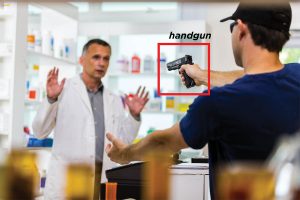— By Dave Fraser —
Protecting facilities with AI gun detection technology.
The grim reality in today’s day and age is that active shooting incidents are on the rise. In fact, according to the FBI, active shooter incidents jumped more than 50% in 2021. And as we already saw with multiple mass shooting events in 2022, and 2023, the problem is not going away. This alarming trend is placing increased pressure on facilities to be ready in the event that a mass shooter walks through their doors. The right level of preparedness will ultimately determine whether lives are saved or lost.

Dave Fraser, Omilert
Fortunately, there are new technologies becoming mainstream to help solve the issue, and one of the most promising is AI-powered visual gun detection. This technology can be easily integrated into existing IP-based video cameras so it extends a company’s already made investment in video surveillance and transforms a forensic tool into a powerful preventive system. The benefit of a system with AI-powered monitoring is that the software is always on and looking for a gun in real-time. This is significant because research has proven that many companies don’t monitor video live and when they do, human monitoring is difficult to do reliably. In fact, research has shown that less than 1% of all surveillance video is actually watched live, and when it is monitored by a human, 45% of activity is missed after 12 minutes of continuous watching, and 95% is missed after 22 minutes. In contrast, AI gun detection is on 24/7 and never gets tired or loses concentration, which means it can significantly help those in charge of security be more successful at keeping their facilities safe.
 Many retail stores already have some form of security monitoring and panic buttons or similar systems that allow their people to trigger an alarm. Unfortunately, people may be unable to do this because of the immediate threat, such as a gunman holding up a convenience store where the employee is not close enough physically to hit the button. In contrast, an AI-equipped visual system can quickly detect the presence of a gun threat and raise an alarm independently of where store personnel are located. And, depending on the security platform in place, it can send trigger alerts, contact the police, lock doors and more.
Many retail stores already have some form of security monitoring and panic buttons or similar systems that allow their people to trigger an alarm. Unfortunately, people may be unable to do this because of the immediate threat, such as a gunman holding up a convenience store where the employee is not close enough physically to hit the button. In contrast, an AI-equipped visual system can quickly detect the presence of a gun threat and raise an alarm independently of where store personnel are located. And, depending on the security platform in place, it can send trigger alerts, contact the police, lock doors and more.
Here’s How AI Visual Gun Detection Works:
AI gun detection software uses a multi-step process to identify active shooter threats, not simply guns.
- Assess: It first assesses frames of video to identify a body. It’s not looking for people or trying to identify a person, just the shape of a body without reference to color, gender or other identifying personal attributes.
- Detect: The AI then works as a gun detector, searching for a gun in close proximity to the body. A wide range of handguns, shotguns, rifles and military-style weapons are distinguished by the AI while inert objects such as cell phones, hand tools, common office objects and more are identified to diminish possible false positives.
- Analyze: Multiple frames of video are then analyzed in sequence to establish a coherent track on the threat, reducing spurious or false detections. Additionally, the relationship of the gun to the arm and hand of the body is analyzed to bring additional clarity to the situation and help determine, with a high level of confidence, if an actual gun detection is in fact an active shooter threat.
A Real-Life Scenario
Below is an example of the sequence of events that could take place in an active shooter incident:
- An active shooter walks up to a store and pulls out a gun as they approach. With a camera mounted to view incoming traffic, the system could identify the shooter before they entered the building. Otherwise, it would fall to the inside camera to identify the gun once it became visible in the store.
- In under a second, an AI-powered visual gun detection system can identify a visible gun and send an alert to a designated person that the store decided on earlier. This could be a security officer at the store or other location or a third-party service. The alert sent would contain a still image, video snippet and details of the location and camera.
- Once the designated person confirms the active shooter threat, they can then initiate a series of actions. These actions are predetermined in the planning process and could include:
- Calling the police.
- Sending real-time data information to first responders that could include information on the number of shooters, what they are wearing and where they are currently located.
- Locking the doors or blocking an entry.
- Sending emergency notifications to people in the area.
- Sending evacuation routes to people inside the building that leverages where the shooter is so that they can identify a safe path out of the building.
Effective Security Also Helps Your Bottom Line
With the rising levels of gun violence, businesses are seeing that costs incurred from active shooter incidents are significant. This is yet another reason to be prepared to stop and/or minimize these types of events. As an example, the Centers for Disease Control and Prevention estimates that fatal injuries can cost nearly $1 million. And, this number doesn’t include costs such as:
- Decrease in employee productivity, morale and quality.
- Damage to customer relations and public image.
- Repair of facility and infrastructure.
- Unplanned administrative efforts.
- Costs of new safety training.
- Increase in insurance premiums.
With the fines and direct costs in addition to the indirect expenses, a single fatality can cost an organization upwards of $3 million. By investing in safety solutions like AI gun detection, you put in place reliable safeguards to protect all aspects of your company.
The Key is Preparedness
Organizations should always look for better ways to prepare for emergencies before they occur. No one can predict where a mass shooter will strike next, but facilities can take steps now to save lives in the future. The key is early threat detection followed by a rapid response and AI gun detection combined with mass communications platforms achieve just that.
— As CEO, Dave Fraser leads strategy and execution at Omnilert. He has been building innovative software products and companies for more than 30 years. Prior to joining Omnilert, Fraser was CEO of wireless pioneer Devicescape (acquired by Pareteum).

